Bosch washing machine makes noise during spin cycle
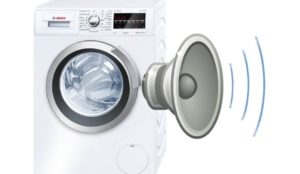 Normally, almost every Bosch washing machine makes noise when washing - absolutely “quiet” models are rare and are very expensive. Many machines operate loudly, the main thing is that the outgoing hum is uniform and not complemented by knocking, grinding or increased vibration. Otherwise, you may suspect a serious equipment breakdown.
Normally, almost every Bosch washing machine makes noise when washing - absolutely “quiet” models are rare and are very expensive. Many machines operate loudly, the main thing is that the outgoing hum is uniform and not complemented by knocking, grinding or increased vibration. Otherwise, you may suspect a serious equipment breakdown.
If the washing machine used to spin more quietly, but now it makes a sharp noise, then you should not ignore this fact. It’s better to take a closer look at the machine and find out the reason for the changed volume.
Causes of loud sound
The machine just doesn't make a lot of noise. There are certain reasons that lead to excessive hum and vibration, which are not recommended to be ignored. Sometimes the problem can be solved by adjusting the housing, but more often a more complex repair with replacement of components is necessary.
As a rule, the washing machine becomes noisier for the following reasons:
- the shipping bolts that secure the tank during transportation have not been removed (when starting the machine, the engine tries to unwind the fixed drum, which leads to knocking and noise);
- the bearing assembly has failed (worn out bearings cannot ensure smooth rotation of the shaft; it rotates intermittently and noisily);
- a foreign object is stuck between the tank and the drum (the tank hits it);
- the pulley has become loose due to a loose nut (in this case, when the drum is untwisted, it loses its intended trajectory and hits the walls of the tank, creating noise);
- the counterweights were not fully fixed (thus the vibration emanating from the machine is not fully damped);
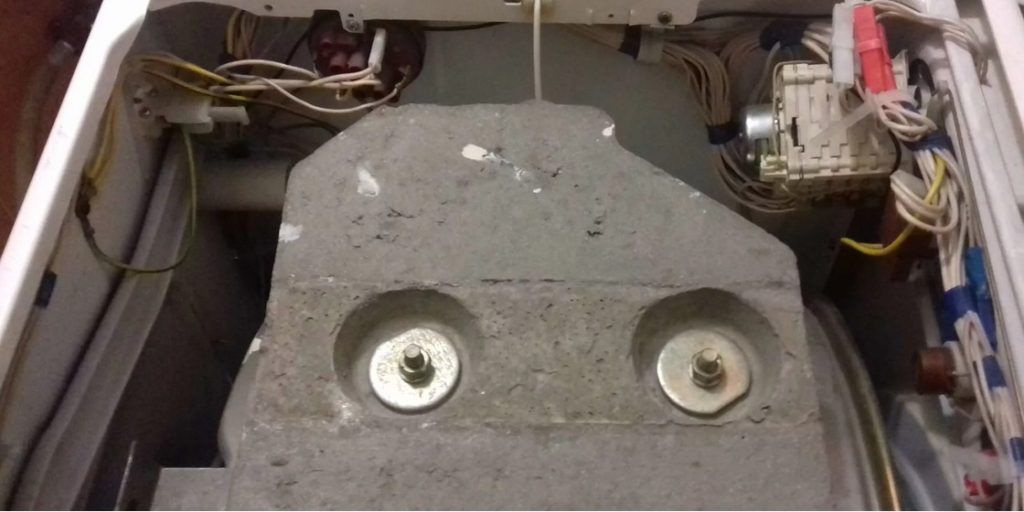
- the hatch cuff has “moved away” or does not fit in size (which also leads to increased noise of the machine);
- The washing machine body is not adjusted (an unevenly installed machine “jumps” during the spin cycle and makes a lot of noise).
If the washing machine begins to make a suspicious noise, it is necessary to carry out a comprehensive diagnostics of the machine!
You can clarify the nature of the problem yourself. Some breakdowns can be detected without disassembling the machine - you just need to listen to the machine and evaluate its behavior. It is important to understand at what stage of washing the equipment begins to make a lot of noise: immediately when the cycle starts, when switching to spinning or when draining. This information will help in finding the cause.
Dangerous foreign object
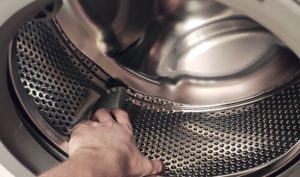 All items loaded into the drum must be carefully checked. Keys, hairpins and coins forgotten in pockets during washing can fall out of their “shelter” and then slip into the tank. It is unlikely that a foreign object will lie quietly at the bottom; rather, with spinning and increased vibration, it will “jump” and eventually get stuck in the rotating element. A bone that falls out of a bra will lead to a similar outcome. In any case, the machine will react to an unexpected “guest” with noise, creaking or rumble.
All items loaded into the drum must be carefully checked. Keys, hairpins and coins forgotten in pockets during washing can fall out of their “shelter” and then slip into the tank. It is unlikely that a foreign object will lie quietly at the bottom; rather, with spinning and increased vibration, it will “jump” and eventually get stuck in the rotating element. A bone that falls out of a bra will lead to a similar outcome. In any case, the machine will react to an unexpected “guest” with noise, creaking or rumble.
It is not difficult to find out whether there is a foreign object in the tank. Just turn off the machine and do a simple test:
- open the hatch door;
- release the drum;
- spin the drum with your palm.
If something interferes with the rotation of the drum, strong resistance is felt, clanging and grinding is heard, then the problem is in the keys or a bone. The problem is solved quickly and without much effort: you need to remove the back panel, remove the heating element, and stick your hand into the hole freed from the heater and take out the “lost item”. The knocking should stop.
The tank is statically fixed
Sometimes a newly purchased washing machine begins to make noise when it is first started.This happens often, and in most cases it is not a manufacturing defect that is to blame, but the user’s carelessness. He forgets to remove the shipping bolts that secure the shock absorbers and starts the wash with the drum not moving. The engine will try to spin the unyielding mechanism, which will lead to noise and loud knocking.

Removing the transport bolts before starting the washing machine is one of the manufacturer’s requirements, which must be included in the instructions. The consequences of operating a machine with a fixed drum will not be limited to knocking and noise: severe damage to the internal parts of the equipment is possible. The latches are removed according to the algorithm described in the manual:
- find 4 transportation bolts in the center of the rear wall of the case;
- unscrew the nuts and remove the fasteners;
- Insert the special plastic plugs included in the kit into the holes.
Starting equipment with transportation bolts is not considered a warranty case - you will have to pay for the repair of the machine out of your own pocket!
Problems with drum rotation also occur if the bearing assembly is damaged. With broken bearings, the washing machine is noisier, especially when accelerating to maximum speed. You can confirm your guess with a simple test: rotate the cylinder left and right by hand. If you hear a creaking or “sandy” grinding noise, it means it’s time to replace the races and seal.
Problems with weights and pulley
Often, a Bosch washing machine makes strange noises when the pulley is loosened. Diagnostics of this unit is carried out using a test washing cycle, in which the drum rotates at minimum speed in both directions. Here it is important to listen to the operation of the machine: if clicks are clearly heard, then the wheel needs to be “tightened”.You will have to remove the back wall of the case and tighten the fixing nut.
Poorly secured counterweights also lead to increased noise levels. Concrete blocks increase the stability of the washing machine, suppress vibrations emanating from the shaft, preventing the machine from swaying and “jumping.” But the harmony is disrupted if the bolts securing the stones are loosened. To solve the problem, just remove the top cover of the washer and tighten the fasteners more.
Adjusting the body will help
The washing machine often makes noise due to improper installation. The instructions describe in detail the installation process of the machine and the mandatory requirements for the location of the equipment. So, place the washing machine strictly level on a flat and hard surface. The position of the body is adjusted by twisting the legs.
An unevenly installed machine will become unbalanced when operating at high speeds. This results in:
- increased vibration;
- knocking, grinding and humming;
- swinging and “jumping” around the room.
Installation of the washing machine must be carried out according to the building level!
The solution is simple and obvious: re-adjust the position of the housing or strengthen the flooring. For prevention, it is recommended to wear special anti-vibration pads on the legs of the washing machine.
Loading hatch rubber
 Extraneous squeaks cannot be avoided when the washing machine is operating if the cuff stretched over the hatch does not fit in size. Moreover, the knocking will appear immediately when the drum rotates and will remain until the program is turned off. Another sign is rubber shavings stuck to the surface of the cylinder. More often, discrepancies in size are eliminated using sandpaper. How should I proceed?
Extraneous squeaks cannot be avoided when the washing machine is operating if the cuff stretched over the hatch does not fit in size. Moreover, the knocking will appear immediately when the drum rotates and will remain until the program is turned off. Another sign is rubber shavings stuck to the surface of the cylinder. More often, discrepancies in size are eliminated using sandpaper. How should I proceed?
- Take a piece of sandpaper.
- We place it on the rubber cuff and press it with the hatch door.
- Let's turn on the quick program.
- We wait until the sandpaper smoothes out the rubber after half an hour of the cycle.
- At the end of the program, take out the paper.
- Run a rinse to get rid of the chips.
- We clean the garbage filter.
If the washing machine starts to make noise during the draining stage, then there is a high probability that the pump is broken. In this case, it is recommended to test the part with a multimeter.
What happened to the new technology?
 The washing machine does not always make noise due to a malfunction or malfunction. If the washing machine hums from the first start, but there are no obvious knocks or creaks, and the noise itself is monotonous and uniform, then there should be no cause for concern. Perhaps this model should be “loud” - in terms of performance characteristics. It’s easy to verify that you’re right: we study the attached instructions and clarify the given decibels.
The washing machine does not always make noise due to a malfunction or malfunction. If the washing machine hums from the first start, but there are no obvious knocks or creaks, and the noise itself is monotonous and uniform, then there should be no cause for concern. Perhaps this model should be “loud” - in terms of performance characteristics. It’s easy to verify that you’re right: we study the attached instructions and clarify the given decibels.
In the technical data sheet, the manufacturer must indicate the maximum noise level that the washing machine produces at the highest speed spin. The parameter is given in dB, however, it is impossible to correlate the hum emanating from the machine with the number by ear. It is necessary to use a special device - a sound level meter.
The permissible noise level of the washing machine is indicated in the technical data sheet.
You can purchase a sound level meter both in specialized stores and on online platforms. The cost varies depending on the functionality and country of origin. Chinese meters can be found for 150-300 rubles.
You can try to estimate the volume of a washing machine without a sound level meter. For example, compare the reproduced hum with known sound “situations”.An ordinary human conversation is estimated by experts at 50 dB, a truck engine operates at approximately 80 dB, a car siren with a diameter of 5 m reaches 100 dB, and a taking off plane reaches 150 dB. The values are approximate, but sometimes they help to “hear” the machine.
The main thing is to evaluate the nature of the noise. The machine should work in the same rhythm, without sharp knocks and clanging. Otherwise, you may suspect a mechanism failure.
Operate equipment carefully
In most cases, the machine begins to make noise due to a malfunction. It is much easier to avoid them than to eliminate them. Prevention consists of careful use of the machine. Thus, the following recommendations will help delay the manifestation of “loud problems”:
- observe the drum loading rate: overweight or underweight leads to imbalance;
- do not use high-temperature modes in a row;
- do not spin at maximum speed - strong acceleration overloads the machine;
- Clean the garbage filter regularly;
- prepare items for washing, sort and check pockets;
- add high-quality detergents that are completely washed out of the fabric and washing machine;
- do not store heavy objects on the top cover of the washing machine - it should be empty;
- place laundry in special laundry bags, especially underwire bras;
- take care to soften hard tap water using special means;
- end using the machine with an “idle” cycle.
It is not recommended to use the equipment too often. It is better not to overload the machine, allowing it to “rest” after three cycles in a row. It is important to take care of the dryness of the machine by wiping it after washing and leaving the door open.
Interesting:
Reader comments
- Share your opinion - leave a comment
Categories
Washing machine repair


For buyers

For users

Dishwasher


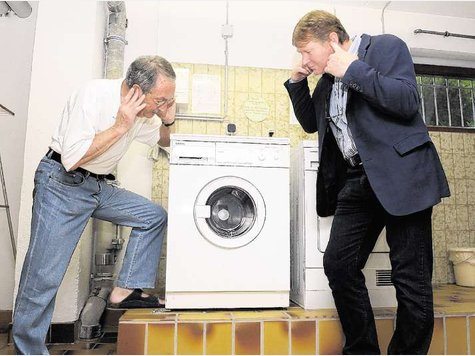
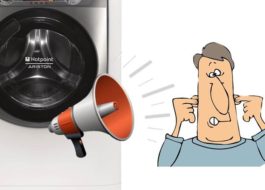

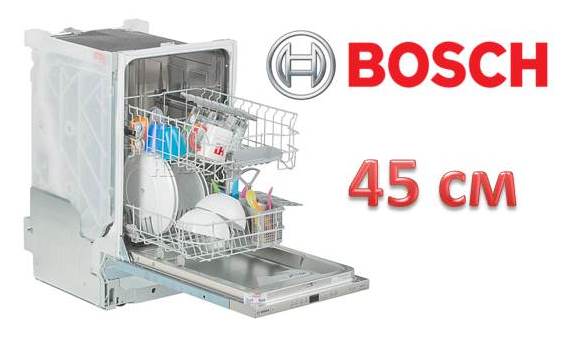











Add a comment